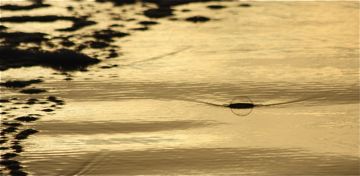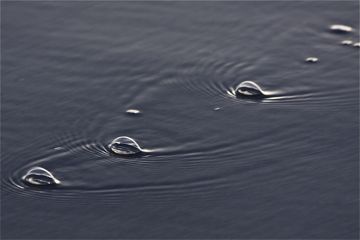Many of you may remember quite a bit of public sparring that occurred between John Hammond and myself over the “What Makes Us Human” post back in September. Since then, John and I have traded many e-mails, ideas, and insights. This week I have invited John to guest blog for the Teaching with Contemporary Art column and give us his own unique take on the relationship between art and science. John Hammond is an entrepreneur in the biotechnology and pharmaceutical development field. He was born into a family of musicians and painters, and during his young life was a professional ballet dancer and choreographer. He then attended college and graduate school, studying mathematics and physics, before heading off to medical school. He has founded a number of companies that develop new technologies for medical diagnostics and biopharmaceutical development. In his free time, he is an active participant in thrill sports such as whitewater kayaking, skiing and climbing, and is an amateur photographer and occasional writer. Enjoy! — Joe Fusaro
It’s an odd irony that our social evolution seems to be taking us closer and closer to insects. The survival of ants and bees is predicated on unyielding societal structures that define the role and function of each member. Each life has a predetermined purpose and corresponding skill set. In return for this specialization, the colony functions with maximum efficiency. By the metric of survival, arthropods are the most successful phylum on this planet. But nothing changes for the colony; at least, not on a generational timescale. Indeed, even after countless generations, the ants that live in my kitchen now behave exactly the same way as the ants that lived in my kitchen when I was a toddler, as far as I can tell.
So why is it that our culture insists on ever greater levels of specialization? Efficiency is part of it, and this has its place. But it also has its dangers, both for the individual and the society as a whole. Taken to its logical extreme, specialization leads to total loss of individual freedom and complete stasis for society. It also leads to terminal loneliness.
As a science-loving child growing up in a family of artists, I struggled with the notion that I needed to specialize. I remember being evaluated in middle school for career interest and proclivity. My well-meaning guidance counselor sat me down and told me I should either be a musician or a scientist. “Or,” I replied, “why not both?” And so began a lifelong dialogue and contemplation of what I consider a false dichotomy: art or science.
To understand the many similarities between these two broad fields, let’s start with a simplistic notion of what separates them: Art deals in subjective truth; science deals in objective truth.
To illustrate the difference, consider the color green. We learn in science class that the color of light is determined by wavelength. A leaf appears green because the light it reflects is a certain wavelength. However, we know from our first art classes that we can make green by mixing blue and yellow. We can mix the two colors and paint an object that looks perfectly green to our eyes. But is this painted object actually green? Subjectively, yes; objectively, no. There is no green light reflected from this object, only a combination of yellow and blue. That fact that we see green is an artifact of our visual apparatus.
In simple terms, art speaks to how we perceive the world; to our experiences and observations, and the entirety of how we process these. But to the extent that art finds an audience and shares these subjective truths, it moves toward the objective. It does so because it reflects both the world around us and how we respond to it. It gives us something to share, and therefore connects us. And in equally simple terms, science attends to the world as it is.
But here’s the fundamental symmetry: to the extent that science finds an audience, it moves toward the subjective. Our collective scientific wisdom teaches us much about our society and ourselves, as well as informs us of the world that exists independent of us. Because of this, it also gives us something to share, and therefore connects us.
So what lies in that vast middle ground between objectivity and subjectivity?
I believe the human aesthetic does.
The media portrays artists and scientists in starkly different aesthetic terms: think of the gallery opening filled with stylish people surrounded by beautiful art and architecture, the extravagant emotive gestures, the complex and nuanced social interactions; think of the lone scientist, hair disheveled, glasses ugly and crooked, tastelessly dressed in a white lab coat, surrounded by noxious looking colored liquids in a drab laboratory, and unable to utter a single warm or comprehensible phrase. These are stereotypes, of course, though not without some truth. We will return to this in a moment.
Aesthetics unify art and science on many levels. At the most superficial, scientists and mathematicians describe their world with a certain poetic flare. Mathematical objects that go to zero are said to vanish. If they approach one, they equal unity. If they get larger without limit, they blow up. The quantum world has its creation and annihilation operators. There are many such words and phrases.
Are these anything more than meaningless ornaments? No more so than the frame on a painting. But what about the painting itself? Isn’t an equation a rigid and cold object that defies human interpretation? A machine that spits out an answer when cranked?
Hardly. Just as a blank canvas can be filled with any number of interpretations of a given subject, so are there an infinite number of equations to describe any single subject. Like paintings, equations are beautiful when they represent a subject clearly, or highlight essential and compelling qualities. Sometimes this takes the form of a very literal rendering of the subject; other times—especially in pure mathematics—it is an abstract representation whose beauty lies not just in capturing salient qualities of one subject, but similar qualities shared by many subjects. And like art, sometimes equations are just intrinsically beautiful.
Moreover, aesthetic principles drive scientific inquiry. Anyone who has taken an introductory course in physics has learned about conservation laws: conservation of energy, momentum, mass, etc. (Conservation in this case simply means that the conserved quantity never changes in time. Momentum may be transferred from one object to another—thus changing form—but the total momentum is constant in time.) Usually conservation laws are presented as axioms; as truths whose proof lies in the predictive power of their application. This is fine as far as it goes. However, these laws are rooted in aesthetics.
During World War 1, the mathematician Emmy Noether proved that conservation laws are a natural and inescapable consequence of symmetry; that for every conserved quantity, there is a corresponding mathematical symmetry. And further, when a symmetry is “broken,” something moves, changes, develops over time, progresses and advances. Symmetry is a fundamentally aesthetic quality that allows us to see complicated relationships in abstract, simplified terms. We view the earth as a sphere because it is far easier to do this than to commit its actual shape to memory.
A perfect sphere has rotational symmetry because it looks exactly the same no matter how we rotate it. The conserved quantity that corresponds to this symmetry is angular momentum: a satellite in orbit behaves the same today as it did yesterday. Its motion is indistinguishable from one day to the next because its angular momentum is conserved. However, if earth’s symmetry were broken, say by a huge volcanic explosion that ripped it apart, then it is quite certain that the satellite would go into an erratic orbit and perhaps crash. Its orbital motion would no longer be the same from one moment to the next because its angular momentum is no longer conserved. It turns out that virtually all of modern physics can be traced back to symmetries—intact or broken. Indeed, the richness of all we observe around us exists because of these symmetries. And to the extent that all science is derivative of physics, symmetries are fundamental.
Well, so what? Haven’t we strayed pretty far afield of art? Perhaps in product, but not in process. And certainly not in the experience.
Like in art, an eye for beauty of form, structure, and relationship takes us to deeper levels of understanding in science. The scientist experiences this with no less visceral and emotional wealth than the artist. We tingle at new discoveries, our minds and hearts thrill when we find an essential quality of the world about us, and there is deep satisfaction when we render the commonplace in new and revealing ways. We appreciate beauty. Like art, science can take us out of our individual worlds and give us profound insights on the world around us—human and otherwise. Like art, aesthetic principles propel us forward, guide us, inspire us.
But what about those Hollywood stereotypes? To the extent they are true, perhaps it is because scientists are more passionate about how the rest of the world looks to them, than how they look to the rest of the world. This distinction aside, most of us move around on the subjective-objective continuum with some fluency, seeking to find meaning and substance in our own lives by understanding what surrounds us and our relationship to it. Retreating to either end of the spectrum is to retreat from being human. Those who live exclusively on the subjective terminus believe that everyone sees as they see. Those who live exclusively on the objective terminus fail to appreciate anything that cannot be proven.
A good education serves to increase our mobility on this continuum. All too often, though, science educators exalt fact over process, perception and expression, art educators just the opposite. This forces us to choose paths, unnecessarily so.
There is no real divide between art and science, save perhaps at the extremes. Those who would force us toward either terminus risk destroying much that makes life worthwhile, what makes us human: either we become a society of isolated and self-centered hermits, or we become a colony of ants.






Pingback: Thinking Like an Artist, Part 1 | Art21 Blog